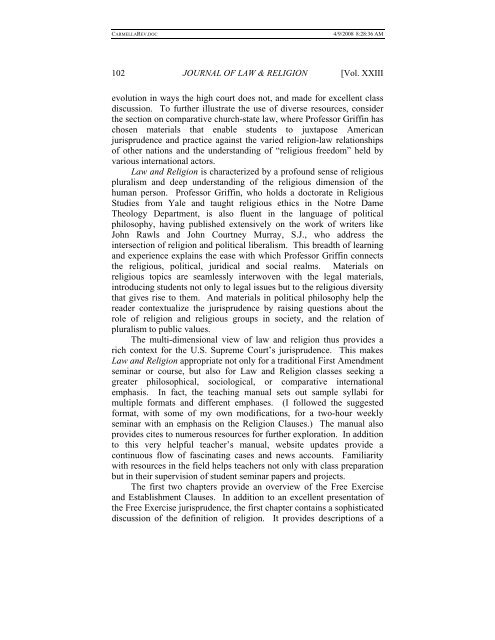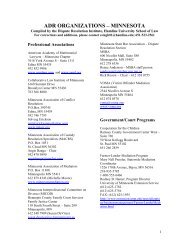LAW AND RELIGION: CASES AND MATERIALS - Hamline Law
LAW AND RELIGION: CASES AND MATERIALS - Hamline Law
LAW AND RELIGION: CASES AND MATERIALS - Hamline Law
You also want an ePaper? Increase the reach of your titles
YUMPU automatically turns print PDFs into web optimized ePapers that Google loves.
CARMELLAREV.DOC 4/9/2008 8:28:36 AM<br />
102 JOURNAL OF <strong>LAW</strong> & <strong>RELIGION</strong> [Vol. XXIII<br />
evolution in ways the high court does not, and made for excellent class<br />
discussion. To further illustrate the use of diverse resources, consider<br />
the section on comparative church-state law, where Professor Griffin has<br />
chosen materials that enable students to juxtapose American<br />
jurisprudence and practice against the varied religion-law relationships<br />
of other nations and the understanding of “religious freedom” held by<br />
various international actors.<br />
<strong>Law</strong> and Religion is characterized by a profound sense of religious<br />
pluralism and deep understanding of the religious dimension of the<br />
human person. Professor Griffin, who holds a doctorate in Religious<br />
Studies from Yale and taught religious ethics in the Notre Dame<br />
Theology Department, is also fluent in the language of political<br />
philosophy, having published extensively on the work of writers like<br />
John Rawls and John Courtney Murray, S.J., who address the<br />
intersection of religion and political liberalism. This breadth of learning<br />
and experience explains the ease with which Professor Griffin connects<br />
the religious, political, juridical and social realms. Materials on<br />
religious topics are seamlessly interwoven with the legal materials,<br />
introducing students not only to legal issues but to the religious diversity<br />
that gives rise to them. And materials in political philosophy help the<br />
reader contextualize the jurisprudence by raising questions about the<br />
role of religion and religious groups in society, and the relation of<br />
pluralism to public values.<br />
The multi-dimensional view of law and religion thus provides a<br />
rich context for the U.S. Supreme Court’s jurisprudence. This makes<br />
<strong>Law</strong> and Religion appropriate not only for a traditional First Amendment<br />
seminar or course, but also for <strong>Law</strong> and Religion classes seeking a<br />
greater philosophical, sociological, or comparative international<br />
emphasis. In fact, the teaching manual sets out sample syllabi for<br />
multiple formats and different emphases. (I followed the suggested<br />
format, with some of my own modifications, for a two-hour weekly<br />
seminar with an emphasis on the Religion Clauses.) The manual also<br />
provides cites to numerous resources for further exploration. In addition<br />
to this very helpful teacher’s manual, website updates provide a<br />
continuous flow of fascinating cases and news accounts. Familiarity<br />
with resources in the field helps teachers not only with class preparation<br />
but in their supervision of student seminar papers and projects.<br />
The first two chapters provide an overview of the Free Exercise<br />
and Establishment Clauses. In addition to an excellent presentation of<br />
the Free Exercise jurisprudence, the first chapter contains a sophisticated<br />
discussion of the definition of religion. It provides descriptions of a
















